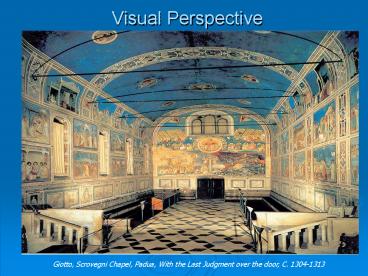Visual Perspective - PowerPoint PPT Presentation
1 / 22
Title:
Visual Perspective
Description:
Being able to see, to understand, and to guide ... Drawing recumbent figures. Drawing people in perspective is a challenging task! ... Drawing recumbent figures ... – PowerPoint PPT presentation
Number of Views:108
Avg rating:3.0/5.0
Title: Visual Perspective
1
Visual Perspective
Giotto, Scrovegni Chapel, Padua, With the Last
Judgment over the door, C. 1304-1313
2
Depth in the World
- Being able to see, to understand, and to guide
ones actions involves being able to differentiate
near objects from far objects. In other words
creating visual perspective. - This requires being able to see in depth.
- The world that we live in has three physical
dimensions, height, width, and depth, however
visual signals are transduced by the visual
system in only two dimensions, height and width. - This means that the brain must create a three
dimensional image through the use of context
cues, and knowledge of the world based on
experience. - In art, 3 dimensional images must be created on a
flat two dimensional surface. This means an
artist must use technique to create perspective.
3
Perspective
- Perspective is the term used in art to refer to
representing a three dimensional object of a two
dimensional canvas. - Although artists had used perspective techniques
for thousands of years before the renaissance it
was during the renaissance that the laws of
perspective were finally understood - In particular renaissance artists found that
changing image size would change perceived
distance, and shading differences also
contributed to perceived distance
4
Principals of Depth Perception
- General Principals of Depth Perception.
- Note that Binocular cues are most important for
close up work and monocular cues most important
for distance
5
Binocular Cues
- Why is Binocular Disparity is important for close
up work? - The two eyes subtend different areas do to
different angles - But this becomes less important as distance
increases
6
Common Binocular and Monocular cues at use in Art
- a
7
Occlusion Relative Size
Giovanni Bellini-Procession in the Piazza of St.
Marco, C. 1496
- Two common techniques used by artists to create
the perspective of depth include - 1) using larger figures in the foreground, and
smaller figure in the - background
- 2) having closer objects occlude more distant
figures
8
Monocular Cues -Shadow
- In this Gentileschi, shadow is used as a cue to
depth. - Depth can be assertained by shadows, such as the
way a shadow is cast on the underside of a ball,
which suggests a solid three dimensional object
- Gentileschi-Judith slaying Holofernes
- C. 1620
9
- In this visual illusion, why does the upper ball
appear larger than the lower - Why do they appear three dimensional
10
Elevation
- In this famous piece by Bellini, Elevation is
used as a cue to depth (what wlse can you find
that is a cue to depth).
Bellini-S. Giobbe Altarpiece, C. 1485
11
Depth and Visual Perspective Elevation
- This famous piece by Masaccio, also uses
elevation to give the illusion of depth
Masaccio-Trinity
12
More examples of Occlusion, Height, Size
Manipulation
- This painting by El Grecco, demonstrates nearly
every monocular depth cue know to artists in this
period
el grecco 1
13
Visual Perspective
- What techniques has Leonardo used to give the
perspective of Depth in This famous Painting?
Leonardo Da Vinci- Mona Lisa, C. 1506
14
Visual Perspective
- What techniques has Leonardo used to give the
perspective of Depth in This famous Painting?
Leonardo da Vinci-Virgin Child with St. Anne,
C. 1508
15
Visual Perspective
- What techniques has Bellini used to give the
perspective of Depth in This famous Painting?
G. Bellini, Madonna of the Meadows, C. 1505
16
Illusion Constancy One Point Perspective
Leonardo Da Vinci-Last supper, C. 1495
- Note that all the lines appear to vanish at one
particular point
17
Illusion Constancy One Point Perspective
Donatello-St. Anthony healing the young man's
foot, C. 1446
- In this famous etching by Donatello, orientation
is used as a cue to depth. Where is the Vanishing
Point
18
Illusion Constancy Multiple Angles
- Many artists use rectangular and flat forms to
create powerful depth cues
19
Drawing recumbent figures
Paolo Ucello, Battle of San Ramano, C. 1430
- Drawing people in perspective is a challenging
task! Compare the fallen figure in the lower left
corner of this painting to other figures. You
will see that the figure is significantly
foreshortened and out of scale with other figures.
20
Drawing recumbent figures
- The use of three dimensional rectangular and
cylindrical forms to guide an artist in drawing
objects and overcome the challenge of drawing
recumbent figures in perspective is a technique
pioneered in the renaissance.
21
Famous examples of foreshortening
Mantegna-The Dead Christ,1466
- A means of drawing reclining figures in
perspective. This portrait was later corrected
to more appropriately portray the Christ figure
in perspective. - These figures are hard to draw because our
psychological perception of what we expect to see
in figures are powerful prototype images that
sway what we think we see.
22
- Leonardo Da Vinci spent years studying the human
body in order to more accurately portray the his
figures
Leonardo Da Vinci-Anatomical Studies, C. 1510































